
July, 2011

Encircled Flux in Flux Is This The Obituary For Copper Wire? Really "Old Tech" Helps Install New Tech Fiber More Ways To Spot Counterfeit Cable (with updates) FOA iPad App Now Available Are We Headed To Another "Tech Bubble"? Update Report on Broadband in America Fiber U at OSP Show in September Fiber U Training Conference For Africa? 3 New FOA YouTube Videos! New @ FOA FOA Corporate Memberships Fiber U - two new free online self-study courses Publications: NECA/FOA 301 Installation Revised, eBooks Online Reference Guide: New pages on BI fiber, data centers, more Tech Topics: More online information Certification: New FOA OSP Certification FOA Schools: New schools and programs FOA Jobs Web Site
Fiber U is back - at the OSP Expo, maybe Africa next year Q&A: Large number of good questions this month, e.g. IR/UV Eye Protection Product News - New Corning Unicam Cleaver, Protecting Pedestals From Rodents Worth Reading: More interesting things we've read (and videos we've seen.)
|
It's now CFOT® and Fiber U® The FOA CFOT® (Certified Fiber Optic Technician) and Fiber U® (the FOA online self-study program) are now a registered trademark. With over 33,000 fiber optic techs holding CFOTs and the CFOT being recognized worldwide as the foremost certification in fiber optics, the FOA realized the value of the CFOT and Fiber U required trademark protection. Now it's official! Want to know more about fiber optics? Free Self-Study Program on "Fiber U®." Looking for specific information? Study for FOA certifications? Here's the largest technical reference on the web: The FOA Online Fiber Optic Reference Guide. New FOA Reference Books(Available Printed or eBooks)
|
| Renew your FOA certification online - plus get a discount coupon for the new FOA books and get an extra month free. Details here. |
|
Encircled Flux in Flux It is unusual for The FOA to get so technical in our newsletter, but the topic of encircled flux (EF) has become a big issue in testing multimode fiber optic cable plants. Contractors and manufacturers are complaining about the technical issues and economic impact of EF - higher testing costs and uncertainty of correllation of test results. If you are involved at all with multimode fiber, you should read this. Comments are invited - email them to the FOA. Now that most of the controversy over bend-insensitive fiber appears to have died down, many in the industry have turned their attention to encircled flux (EF), a new metric for mode power distribution in multimode fiber. EF is a very sophisticated way of defining mode power distribution. It was created as a theoretical description of an ideal VCSEL for bandwidth simulations by the Ethernet committe while developing the MM solution for 100GB Ethernet. From there, it evolved into a way of defining mode power distribution for testing. Many thought EF was a way of replacing CPR/mandrel wrap for controlling mode power distribution, which is not true. The CPR/mandrel wrap technique included in many standards like TIA OFSTP-14, the standard for testing installed multimode cable plants, is a method of controlling mode power distribution while EF is a way of specifying and/or testing mode power distribution. This distinction is very important to understand. When TIA voted to replace the old OFSTP-14 with the new international standard, it replaced instructions on how to control mode power distribution with a way to measure it, leaving the tech doing testing to come up with their own solution! Furthermore, testing EF is not a proven technique. In fact the first round robin done by manufacturers' R&D labs was inconclusive and a new round robin is underway, expected to finish sometime in 2012. The international documents associated with EF are hardly user-friendly. Below is the definition of EF from IEC 61282-11 TR Ed. 1.0: Fibre optic communication system design guides - Part 11: Multimode launch conditions.  Quite obvious, eh? It's followed by pages of similar equations. But the perpetrators of EF were not finished. Using data taken on simulated 100G MM OM3 fiber links, they showed that for these links of under 2 dB loss, that measurements of insertion loss with a light source and power meter and a mode modifier that supposedly met EF standards were the same as measurements taken with an OTDR. Let me repeat that: On a 2 dB link using EF, a insertion loss test and an OTDR test gave similar results. So then, based on that limited data, they decided that the international standard for testing multimode loss should allow testing with either a light source and power meter or an OTDR. Did the industry "experts" writing these standard understand that OFSTP-14 applied to links other than 100G links of less than 2 dB? What happens with the installer working on long CCTV, industrial or utility links? Multimode fiber links can be up to 10 dB or more! Where is the data that shows that a light source and power meter and an OTDR give the same loss measurement at 5, 10 dB or more? Five years ago, the FOA sponsored research on this topic. Eric Pearson and Jim Hayes examined the OTDR vs light source and power meter issue using the same mode conditioners that are being sold today that are supposed to make the two measurements coincide. Here are the results. It does not come to the same conclusion.
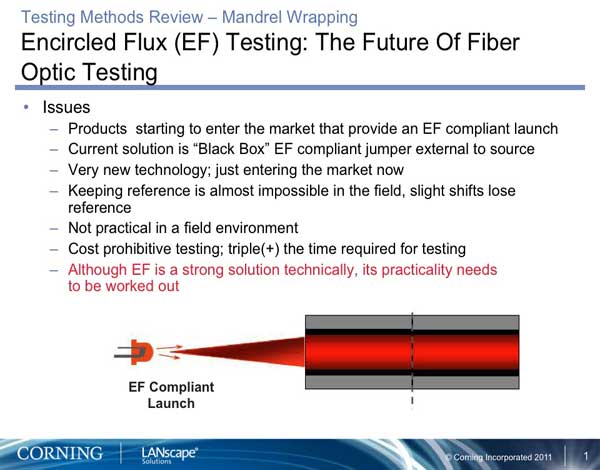 Note what Corning says: "Not practical in a field environment" But wait - there is a solution! First, if a customer tells you that OTDR testing is required, tell them that OFSTP -14 allows testing with either an OTDR or light source and power meter and the latter is much cheaper and tests the cable plant in the manner in which it will be used. Secondly, and extremely important, hidden in the international document mentioned above (IEC 61282-11) are the following statements: The target weights for 50 μm optical fibre at 850 nm have been studied most extensively.That's right, EF is - certainly within the limits of current EF measurement capability - basically the same as the old CPR/mandrel wrap that has been in industry standards for almost 20 years now! So if someone tells you to buy $1700 worth of mode conditioning patchcords, just tell them that EF and the same old CPR/mandrel wrap are considered to be close enough in international standards! In fact, if you need technical backup on this issue, feel free to contact the FOA. We have no vested interest in this issue other than making sure everyone knows the truth not the hype and helping correct the current standards documents to make sense. Finally, the FOA has been in discussions with many groups about how to give directions on building mode modifiers at inexpensive prices. We hope to have more information on this topic soon. If you are a manufacturer and want to work with us, contact FOA. More technical information on EF is on the FOA Online Reference Guide page on EF. Much has been written in the press about EF, e.g. Eric Pearson in CI&M, Jim Hayes in CI&M, CI&M Webinar. Add it to your calendar, September 13-14, 2011: 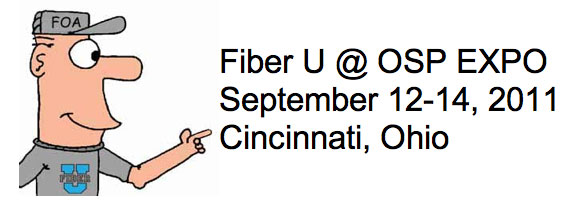 Fiber U Returns @ OSP EXPO Some of you may remember the famous "Fiber U" training conferences of the 1990s where dozens of vendors and hundreds of students converged for a week-long training conference. Now Fiber U is part of the FOA. This year we've been invited to work with OSP magazine to present seminars at their annual conference. We'll have sessions on Fiber Optics in SmartGrid, Fiber for Wireless and Gigabit FTTH. Here is complete information on Fiber U at OSP EXPO OSP EXPO, September 13-14, 2011 will be held in Cincinnati, Ohio. 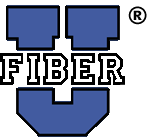 @ @  Fiber U Training Conference For Africa? The current FOA schools in Africa ( Triple Play Fibre Optic Solutions in SA, African eDevelopment Resource Centre in Nairobi and ICT Resources Center in Lusaka) are actively training workers needed to expand communications in Africa. To assist their efforts, the FOA is looking at the possibility of a "Fiber U for Africa" in 2012, a major training conference that would bring experts and manufacturers from around the world to Africa to train workers on the latest technologies. Stay tuned. Click here for more photos of the FOA Seminars in Africa in May 2011 Download the FOA Presentation from the Africa Seminars (PDF, 15 MB) Is This The Obituary For Copper Wire?  In a recent issue of OSP Magazine, Don McCarty, the acknowledged expert on telco copper plant, wrote a column entitled The Disaster of Placing FTTN Triple Play Service on a Trashed Copper Infrastructure.
Don may well have written the obituary for telco copper wiring when he
wrote "Sadly, much of the copper infrastructure is in complete disarray
and needs to be brought up to quality standards that are far more
stringent than what was required for a Public Switched Telephone
Network (PSTN)." He also said " For those who haven’t invested in
ongoing proactive maintenance, you have years and years and years of
wearing down your cable and, unlike PSTN, if you don’t fix it right, it
simply won’t support Triple Play." He thinks it all started at
divestiture. In a recent issue of OSP Magazine, Don McCarty, the acknowledged expert on telco copper plant, wrote a column entitled The Disaster of Placing FTTN Triple Play Service on a Trashed Copper Infrastructure.
Don may well have written the obituary for telco copper wiring when he
wrote "Sadly, much of the copper infrastructure is in complete disarray
and needs to be brought up to quality standards that are far more
stringent than what was required for a Public Switched Telephone
Network (PSTN)." He also said " For those who haven’t invested in
ongoing proactive maintenance, you have years and years and years of
wearing down your cable and, unlike PSTN, if you don’t fix it right, it
simply won’t support Triple Play." He thinks it all started at
divestiture.Telcos are facing a continual decline in use of landlines as more, especially young, users only use their mobile phone. The push toward smartphones makes this decline in landlines even worse. Triple play on FTTC (fiber to the curb) needs quality copper connections, maybe even two pairs or more to bond together for ADSL. But the neglect of the copper infrastructure and the loss of the older techs who understood copper make it harder to find useable copper for the curb to subscriber connection. When Bellcore/Telcordia published a report on the costs of FTTH in 2004 (The Bernstein Research - Telcordia Report), it stated that FTTH would pay for itself in reduced maintenance of subscribers connections. Now, it appears that FTTH is becoming the only solution for landlines as the current copper is becoming inadequate. Really "Old Tech" Helps Install New Tech Fiber 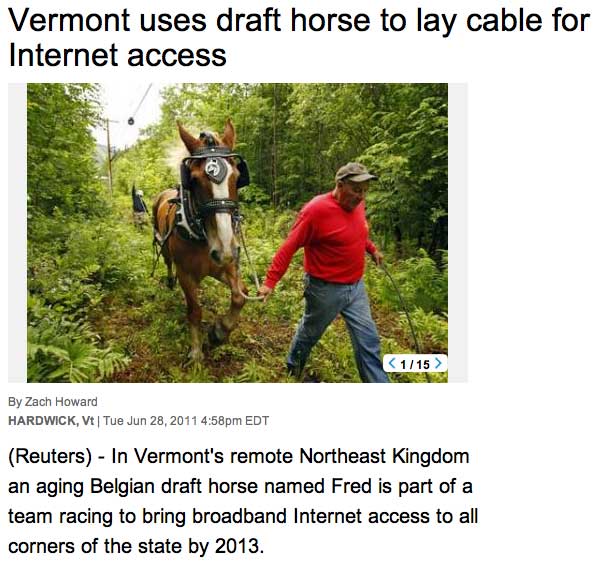 In Vermont's remote Northeast Kingdom a Belgian draft horse named Fred is helping to bring broadband Internet access to all corners of the state. The horse, 14, and his owner, Claude Desmarais, 66, have hauled miles of fiber-optic cable and rigged it to telecommunications lines. It is part of a plan to get Vermont wired for broadband and cell phones. The man and animal are indispensable to cable and phone-service provider FairPoint Communications because they can access hard-to-reach job sites along country roads where utility trucks often cannot. Read the Reuters Article. More Ways To Spot Counterfeit Cable (updated) You might remember that a few months ago we ran a article on some Cat 5 UTP cable that was counterfeit. The manufacturer had gone to all the effort to replace expensive copper wires with cheaper copper-plated aluminum. ( FOA Newsletter, 3/11) A reader who was in a test lab suggested a quick way to find the fake cable - weigh it. A 1000' box of Cat 5 copper will weigh ~21 pounds (9.5 kg) while the fake cable with aluminum wire will only weigh ~14 pounds (6.4 kg). If a cable has a UL File Number printed on the side, you can go to the UL website for their Online Certifications Directory and check the number to see if it is real. We received several comments that are worth including: Note, some brands have a plastic spool, and this adds 2-4 lbs per box. We’ve found that some generic brands can weigh as much as 25 even 30lbs for a Unshielded Twisted Pair Cat5e Bulk Cable. This extra difference can make a counterfeit cable appear to be the same weight as a legitimate version. Another quick way is to spot the “UL Sticker” which is holographic. The counterfeits tend to just “stamp” UL on the box, and write it on the jacket; but they cannot get the printed logo on the holographic sticker. If you get a plain white sticker that says “UL” on it… take a close look. Many times the counterfeiters will cut costs on all corners (so the reel-in-box may be rare), so if it looks like there is minimal printing, or colors that fade/wipe away on the center conductors easily (meaning cheaper powder in the pigment dyes were used); it’s another good sign that it may be counterfeit. The best place to look to confirm is the UL website for the Certification, as listed in the article. The holographic UL sticker may still be a counterfeit - they are counterfeited for DVDs and CDs already. (ed) A couple of months ago, when I was visiting China, I was told by a street vendor about the non-copper cat5e/cat6 cables. He demonstrated to me by cutting the wires into small sections and picking them up with a magnet. They are also producing RJ-45 jacks with low or no gold plating. Plated steel will weigh almost as much as copper, so the weight trick won't work here. And who knows what the inside of these jacks look like - there are tricks used for Cat 5 and above to reduce crosstalk. (ed) Note: We've focused mainly on the performance characteristics of the cable. However, the flammability of the jacketing and insulation are major safety issues. Another response to this article noted some cable imported with "Plenum PVC" markings failed burn tests. While bad wire can cause cable to fail performance tests, bad insulation may not show up until a fire happens when it becomes deadly. (ed) "Tech Puzzler" Is Back This Month! FOA iPad App Now Available 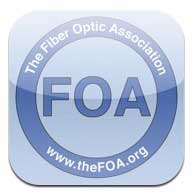 The
FOA has just released its first APP for the iPad, a
self-study version of the FOA Reference Guide to Fiber Optics. The
FOA has just released its first APP for the iPad, a
self-study version of the FOA Reference Guide to Fiber Optics. The FOA APP builds on the FOA basic fiber optic textbook to create an interactive learning environment that builds on the iBook electronic version of the book to add a guide to use for self-study and real-time testing that provides feedback on what you have learned and correct answers to questions answered incorrectly. The FOA APP is priced at only $9.99, same as the iBook, so the self-study program is free. Download it from the Apple APP Store with your iPad or iTunes. http://itunes.apple.com/us/app/foa-guide/id434354283?mt=8&ign-mpt=uo%3D4 Are We Headed To Another "Tech Bubble"? Some people are starting to talk about another tech bubble since stock prices of new Internet IPOs have been priced very high. Since most of them depend on having lots of bandwidth, and that's our business - fiber optics. Here's one article on this subject. Update Report on Broadband in America Professor Robert Atkinson of The Columbia Institute for Tele-Information has released an update to his Broadband in America report of 2009 which was used as the basis for the National Broadband Plan. The Columbia Institute for Tele-Information (CITI) is a university-based research center focused on strategy, management, and policy issues in telecommunications, computing, and electronic mass media. The report estimates that fiber to the home (FTTH) was available to about 15.2 million homes (homes passed) in March 2009, 18.2 million in March 2010 (an increase of 20 percent), and 21 million in March 2011 (an increase of 14.6 percent). In 2009, the largest provider of FTTH service, Verizon, announced that it would complete its FTTH deployment and be capable of serving 17 million locations by 2010. That means that 81% of all FTTH customers in the US are Verizon FiOS customers! The other 19% are served by over 700 other providers. What about AT&T? Here is exactly what the report says (editors italics) : "The other large telephone company, AT&T, announced it would offer DSL from fiber‐fed cabinets (fiber to the neighborhood: FTTN‐DSL) to 30 million homes by 2011.11 AT&T currently offers advertised speeds of up to 18 megabits per second downstream12 (although the actual speed can be much lower), with increases possible with pair bonding." "Overall DSL broadband additions have been negative since the second quarter of 2009. To compensate and compete with cable, telephone companies have been steadily converting pure DSL services to hybrid FTTN‐DSL by pushing fiber closer to customers’ premises as well as by deploying additional FTTH." See Has The Obituary For Copper Wire Been Written? above. On backbones in America: AT&T finished a backbone network upgrade to OC‐768 in 2008. That implies a transmission speed of 40 gbps in 80,000 miles of its network infrastructure. Global Crossing operates approximately 18,000 miles of fiber optic Internet backbone in North America (including Canada). Level 3... operates 27,000 route miles of cable with its newest deployments operating at 40 gbps. Qwest is one of the largest backbone operators... Its backbone reaches across the U.S. and is available in almost every state. Currently its backbone operates at transmission rates of 40 gbps but the speed will be upgraded to 100 gbps during 2009 and 2010. Verizon currently operates its backbone at 40 gbps and is planning to upgrade to 100 gbps beginning in 2009. XO is currently operating a backbone network of 18,000 miles operating at 10 gbps. It is currently undertaking many enhancement projects including a deployment of 1.6 terabits ‐ capable systems on selected inter‐city routes. The report is filled with useful and interesting information including Capex estimates and also has a complete listing of all announced broadband plans, useful information for contractors. You can download the entire report here. Events of Interest  @ @  Fiber U Returns @ OSP EXPO, September 13-14, 2011 Some of you may remember the famous "Fiber U" training conferences of the 1990s where dozens of vendors and hundreds of students converged for a week-long training conference. Now Fiber U is part of the FOA. This year we've been invited to work with OSP Magazine to present seminars at their annual conference. We'll have sessions on Fiber Optics in SmartGrid, Fiber for Wireless and Gigabit FTTH, plus a special session with vendors offering hands-on training on their latest products - just like the old days! Here is complete information on Fiber U at OSP EXPO OSP Expo, September 13-14, 2011 will be held in Cincinnati, Ohio. AFL to Host "Traveling" Advanced Splicing Seminars AFL has launched advanced splicing seminars intended for industry engineers and professionals, as well as university students, engaged in fiber optic activities involving splicing and for those interested in learning more about fusion splicing technology and methods. The seminars, which will take place around the US, will include
Free Corning "See the Light" Seminars Corning is offering free 3 hour seminars on "Termination Technology" in over a dozen cities around the US in the coming months. The seminars focus on new termination techniques and will give attendees real hands-on training. You must pre-register for the seminars, and we recommend you do so soon as they will probably fill up quickly! Register at http://registration.corning.com/1STL%2D2011/  What's New @ FOA What's New @ FOA
 Two New Free Fiber U Self-Study Programs on Outside Plant Fiber Optics and OTDRs There are two new free online self-study programs on Fiber U. "Outside Plant Fiber Optics" uses the new FOA textbook and online reference guide to OSP to help you learn about OSP fiber networks. The "Understanding OTDRs" self-study program will help you learn how to properly use these complicated instruments and there is a free OTDR simulator you can download to use for practice. FOA Certification On Outside Plant Fiber Optics The new FOA CFospT outside plant certification focuses on OSP fiber optic network design, installation and maintentance. A CFospT certified tech must know the ways that fiber is used in the OSP, how it is installed, tested and maintained. While a CFOT might only have a basic knowlede of fusion splicing and OTDR testing, for example, a CFospT will be knowledgeable and skillful in those areas - and more. Reference materials for the new CFospT are the printed textbook, the FOA Reference Guide to Outside Plant Fiber Optics (right) as well as eBooks from Amazon for the Kindle or Apple for the iPad/iPod/iPhone and the OSP reference section of the FOA Online Reference Guide which now includes a self-study guide to the CFospT exam. More information on the FOA Outside Plant Fiber Optic Technician (CFospT) certification. Want to know more about OSP? There's OSP Magazine for that - and a trade show, OSPExpo, running this fall in Cincinnati.
   We have created three new FOA books to be used in training for FOA certifications and as reference books for contractors, installers and end users of fiber optics. These books have full curriculum support, including free curriculum materials for teaching FOA certification courses. Because we are self-publishing these books using more modern "publish on demand" technology, they are easier to keep up to date, easier to buy and much, MUCH cheaper! All are now available in print and electronically in Kindle and Apple iBook versions. The basic fiber optic book is also available as a self-study program in an Apple APP for iPad/iPhone/iPod. Details on the new book each of the new books are at the book pages linked to the photos above. 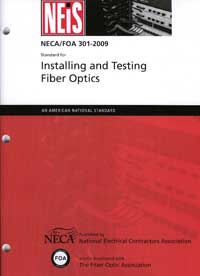 Standards cover components and systems and how to test them, but rarely get into installation issues. The FOA NECA 301 standard which covers installation of optical fiber systems has been revised for the second time, adding considerable new materials. This standard is derived from FOA educational material put in standards form and approved by ANSI as an American National Standard. It's specifically written to be used in contracts to define "installation in a neat and workmanlike manner." The standard is available from NECA. Lecture 5, 6 & 7: Fiber Optic Splices and Connectors 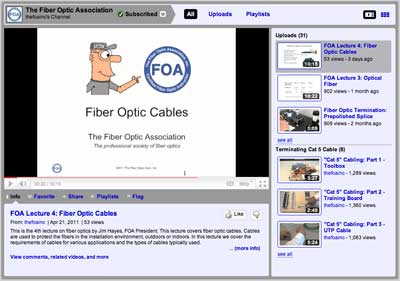 The fifth, sixth and seventh lectures in our series on fiber optics is now online. It covers fiber optic splices and connectors in 3 parts. View the FOA YouTube video Lectures. The FOA is dedicated to make technical material readily available to all those interested in fiber optics. For all 15 years of our existence, we've created reference materials in the form of printed textbooks and web pages. Now our Online Reference Guide has grown so large it needs it's own Google Search and we offer all three of our new books on the Amazon Kindle or Apple iPad/iPhone/iPod. Recently we started our own channel on YouTube and the response has been enthusiastic. So we've been adding more videos to YouTube, including a demonstration of how to use your cell phone camera to detect IR light in fiber systems and have started a lecture series on fiber optics. The first lecture is called "Fiber Optics and Communications" and FOA President Jim Hayes describes the many different uses of fiber in telecommunications, CATV, security, utility and many other networks. Lecture #2 is about Safety in handling and installing fiber. Future lectures will cover the basics of fiber and cable, termination and splicing, installation and testing. Watch for more. FOA Online Fiber Optic Reference Guide New Web Page on Bend Insensitive Fiber Bend-insensitive fiber is a "hot topic" now - we try to explain how it works and what it means for installation and test. Basic Fiber Design Section Updated Lots of new materials added to this introduction to fiber optic network design. New Web Page on Data Centers Data centers are the heart of the Internet, storing and supplying data for user requests. Needless to say, high performance cabling is needed to move the data between storage, servers and routers. We've created a new pagein our Online Reference Guide on data centers - how fiber and cabling are vital to their performance. Learn More About OTDRs - Download a Free OTDR Simulator More and more installers are being asked for OTDR testing but using these instruments is not easy. They are hard to set up properly and complicated to interpret the traces. Using the autotest function can lead to disastrous results! The FOA has a good tutorial on OTDRs on our Online Reference Guide and we added a free download of an OTDR simulator to the OTDR section so you can learn how to use an OTDR on your PC. New OSP Reference Section on the FOA Online Reference Guide website Joining our basic fiber optics and premises cabling sections on the FOA Reference Guide website is a new outside plant reference section that covers materials like that in our new textbook. The material is ready for use and will be followed shortly by a self-study guide. Both the OSP textbook and website are references for the new FOA CFospT outside plant technician certification. More New Info: Links to manufacturers and distributors of fiber optic lighting products. The FOA Online Fiber Optic Reference Guide has become very popular - perhaps the most popular technical website ever, typically with over 270,000 users downloading about 1.6 million pages in 2010! We continue updating materials regularly, keeping it as up to date as possible. Find What You Want Using "Google Custom Search  There's
so much information on the FOA Tech
Topics and Online Fiber Optic Reference Guide
that even a well-organized Table of Contents isn't enough and when the
material is always changing, an index is impossible to maintain. So the
FOA is using the latest technology in search, Google Custom Search,
which will allow you to search just the
FOA Tech
Topics and Online Fiber Optic Reference Guide for
any topic you want to find more about. Try
it! There's
so much information on the FOA Tech
Topics and Online Fiber Optic Reference Guide
that even a well-organized Table of Contents isn't enough and when the
material is always changing, an index is impossible to maintain. So the
FOA is using the latest technology in search, Google Custom Search,
which will allow you to search just the
FOA Tech
Topics and Online Fiber Optic Reference Guide for
any topic you want to find more about. Try
it! Go to The FOA Online Fiber Optic Reference Guide. School News FOA Approved School Student Wins Ohio SkillsUSA Telecommunications Contest Vanguard-Sentinel Career & Technology Centers hosted the SkillsUSA Telecommunications contest for Ohio in April. We had 12 students from other schools in Ohio who entered the contest, and I am very proud to say my student took GOLD. My student will now be representing the State of Ohio at SkillsUSA Nationals in Kansas City MO the last week of June. The best part is he is only a junior student so he can compete again next year. A feather in your hat is the fact that everything I taught him was from FOA curriculum. I just thought you should hear our success at my school and know your training material is creating champions not only in the workplace but also in skills contests. I have been getting a flood of e-mails asking what we use to train our students. I told them all that one place has everything they need to teach Telecom and that being the FOA. Once more thank you for providing great learning opportunities for our students success. Wish us luck at the Nationals... Floyd Collins CCNT-2 Instructor Vanguard-Sentinel Career & Technology Centers, FOA Approved School #135 Fremont, Ohio 43410  New Schools The FOA welcomes the newest additions to our listing of FOA-Approved Training Organizations:
Want to Own The Best School in Canada? Mississauga Training Consultants is looking for a new owner. This 15 year old company is a great opportunity for someone who has fiber experience and likes to teach. Also a great way for a current school to establish a presence in Canada. William will work with the new owner for up to six months to help them get established and grow. If there is not a new owner by April I will consider breaking the company up and selling it in pieces. The web site www.fiberoptictraining.com has top rating. William Graham, CFOS/S/T/C/D/, CFOI Mississauga Training Consultants email: mr.bill.graham@sympatico.ca www.fiberoptictraining.com Tel: 905-785-8012 Cell: 416-659-8713 Find a listing of all the FOA-Approved schools here. It's Now A Lot Easier To Find A FOA-Approved Training Organization 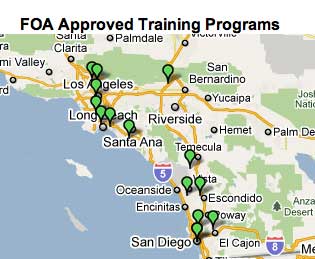 Most phone calls we get regarding finding a FOA-Approved training organization want to know two things: what school is closest to me or what school offers the certifications I need. That can be difficult, since the FOA has almost 200 training organizations we have approved worldwide! We've been looking at ways to make it easier, and we think we've got a good solution. In fact we have two solutions. First we have added a sortable table of all the FOA-Approved schools. You can also use our FOA Google Map Application to find FOA-Approved schools. Here are links to the sortable table of all the FOA-Approved schools and FOA Google Map. What Should A Fiber Optics or Cabling Tech Know and What Skills Do They Need? The FOA has been updating its lists of KSAs (Knowledge, Skills, Abilities) for fiber and cabling techs. The updated list is now on the website for your information and comments - as fiber and cabling KSAs evolve as new technologies develop. KSAs for fiber and cabling techs. Good Question! Tech Questions Worth Repeating Tech Hint: Did You Know You Have A Fiber Optic Tester In Your Pocket? Yes! The camera in your cell phone is sensitive to infrared light - lots more than your eye - and can detect light in an optical fiber or from a transmitter. Chris Hillyer,CFOT/CFOS/I, Master Instructor, Northern California Sound & Communication JATC sent us some photos showing how this works. See below or the video now on YouTube. Underwater Connectors Q: I need to run fibers underwater and pass the signal (about 200 um dia.) through a "bulkhead" or a "feed-through" into a dry side of a container. So I'm looking for standard type ST, etc. connector that I might be able to pot and make water tight. I figure that the fiber optics industry ran millions of miles undersea -- there must be an off the shelf solution. yet i run into companies that offer to design a custom solution that will cost the arm and a leg! A: What you need is a "fiber optic feed through." If you google that you find dozens of them. They are used for undersea remote-piloted vehicles and links. The usual telecom undersea cables are installed as one continuous cable ( even thousands of km long ) and terminated onshore. Fiber Optic Safety Q: Are you able to tell me if there has been any reports of accidents with fibre optics e.g. someone getting shards in the hand and then the shard being taken up in the blood stream or people with vision loss due to working with fibre optic? A: The two you cite are the classic myths of fiber optics. Eye safety is covered in the US in an ANSI standard document, Z136.2, a subset of laser safety. Since fiber output is divergent, not collimated like a laser pointer, and at infrared wavelengths, the safety concerns are less. Laser pointers you can buy at a stationery store are more dangerous. Most fiber systems with high power automatically shut down if the connection is opened also. Techs are always taught to not look into the fiber without checking if power is present. You can do that with a cell phone camera: http://www.youtube.com/user/thefoainc#p/u/8/T4ovUzKhXU0 The fiber shards in the bloodstream story has been around as long as I've been in fiber (>30 years) and I have no idea how it got started! I've had shards stuck in my fingers and they create a spot that first infects, then becomes hard before the fiber is ejected. Getting them into your eye is a bigger problem because the tears make them practically invisible. Safety glasses are mandatory. Bigger problems have been digging up hazardous electrical or gas lines or electrocution when working near high voltage aerial lines, plus the usual hazards of working with cable and machinery. More on safety. Did you download the safety poster we offer? Download a safety poster from the FOA! IR/UV Eye Protection Q: I was given your information from a vendor who sells safety glasses, with the recommendation that someone with your organization might know the names of providers of safety glasses which protect from infrared in the 1310-1550nm range. I read through some of your literature online, and I see that it states that injury is unlikely to occur at those wavelengths; however I believe that better safe than sorry and so would like to find a provider of such glasses. Any information which you could provide would be greatly appreciated. A: While it is highly unlikely to incur eye damage, it is good practice. Lab suppliers like this offer UV/IR protective eyewear. http://www.labsafety.com/eyewearguide/ Changing From 62.5 to 50 micron MM Fiber Q: Right now we use 62.5 micron to connect our legacy system (desktop). Do we need to upgrade our hardware if we move to 50 micron ? A: There are several answers to this question, which we will address separately not so much providing answers as outlining issues that need addressing. 1. Interconnecting 62.5 and 50 micron core fiber, as in patch panels: This is generally not a good idea. The difference in core size and numerical aperture (the angles of light accepted by the fiber) between 62.5 and 50 micron fiber causes the amount of light loss in connections between two fibers to be highly directional. Depending on the types of transmitter sources, the excess loss causes by the mismatched fibers can be as large as 1.6 dB (http://www.thefoa.org/tech/fib62-50.htm) when going from the larger 62.5 micron core fiber to 50. The loss in the other direction (50>62.5) may be slightly less than connecting equal size fibers due to the lesser sensitivity of the fiber connection to geometric offsets, but not enough to offset the loss of the opposite connection. Many systems have enough loss margin to easily accommodate this much excess loss if the links are short and losses are well under the maximum allowed loss budget (http://www.thefoa.org/tech/lossbudg.htm) 2. Coupled power from sources may be lower: Due to the smaller core size and numerical aperture (the angles of light accepted by the fiber) of 50 micron fiber, the amount of light coupled from the transmitter of the equipment may be lower. LED sources have a larger difference as their light patterns are more unfocused, often overfilling all multimode fibers. 850 nm LEDs and surface emitting 1300 nm LEDs have greater differences than 1300 nm edge-emitting LEDs which were used in some FDDI and ESCON systems in the 90s. VCSEL sources used in most systems at 1 Gb/s - and many current 850 nm data links - will have much less difference because the light from a VCSEL is more tightly focused into the center of the MM fiber core. Regular 1310 nm SM lasers used in some data systems will effectively see no difference. This is something easily tested. You need a 62.5 micron patchcord, a 50 micron patchcord and a power meter. Test the coupled power from a transmitter with the power meter using each patchcord and note the results. The difference in coupled power needs to be subtracted from the loss budget when using 50 micron fiber. The narrower beam from the 50 micron fiber may make coupling to receivers more efficient, but that's a tricky one to test. Some equipment manufacturers will provide loss budgets for both fibers, so you can avoid the testing. In the last decade, most fiber optic communications systems will work equally well with either fiber type. Particularly premises systems, like your desktop connections, generally have plenty of margin with either fiber type. Some systems like CCTV cameras my have links long enough to cause concern. But the simple tests above, or a review of equipment documentation, will settle the issue. You can find much more information on the FOA website, particularly our online reference guide (http://www.thefoa.org/tech/ref/contents.html) and we have a special site for users of fiber optic systems that may be helpful ( http://www.thefoa.org/user/index.html print version http://www.thefoa.org/tech/guides/UG3.pdf). Standard For Installation? Q: Is there a standard for testing and certification of installation in an industrial environment? A: The FOA has worked with NECA to create ANSI/NECA/FOA 301, an installation standard for this purpose. It's intended use is to be used as a document defining proper installation for contracts. I can send you a copy if you like. You might also find these pages on our reference website useful: Section for users of networks: http://www.thefoa.org/user/index.html PDF to print: http://www.thefoa.org/tech/guides/UG3.pdf Section on project paperwork: http://www.thefoa.org/tech/ref/install/paperwork.html Designing fiber optic networks:http://www.thefoa.org/tech/guides/DesG.pdf That's Why They Call Them "Dust Caps" Q: We clean a connector, inspect it to ensure it is clean then put the dust cap on. If we inspect it after we remove that dust cap, it's dusty again, we assume from dust in the cap. I have tested different types and makes of dustcaps for the LC and clean ones are rare. If you only push them on half way it helps.....sometimes, but not always. Does any company make clean (guaranteed) ones? A: I've been saying for years that the reason they call them "dust caps" is they contain lots of dust. I know of no clean ones. Think about how they are made in millions and dumped in big bins in a factory! You just have to clean connectors when you remove them. Have you tried some of the dry cleaners? They seem to work well. Fiber Cleaning This is a topic we keep reminding everybody about, and here is why: From a contrator in the Middle East: Here some samples of the connectors for SM fiber already installed in the system we were testing. 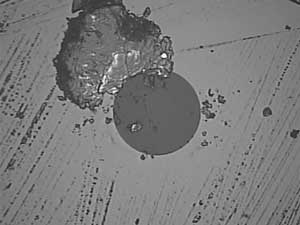 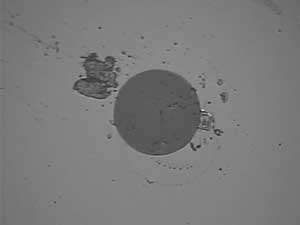 As you can see, the dirt is large compared to the size of the fiber (dark gray), and the core (not visible here) is only 9/125 of the overall diameter of the fiber! More on cleaning. See Product News below for links to vendors of fiber cleaning products. Measurement Uncertainty: Everyone testing fiber optics should understand that every measurement has some uncertainty - whether you are measuring loss, length, wavelength, power, etc. Knowing that uncertainty is very important to interpreting the measurement. It's worthwhile to read and understand the issue of measurement accuracy covered in this page of the FOA Online Fiber Optic Reference Guide. Worth Reading or Watching: Smart Grid The National Association of Electrical Distributors has created a nice overview of "smart grid." It covers a brief overview of the US electric power system, an understanding of why the smart grid has become a national priority, a snapshot of the various electrical components and concepts that are part of the smart grid, advice on how your business can get involved and a look at some key players who should be on your radar if they aren't already. Go to the NAEC Smart Grid website and download their Quick Start Guide. Data Transfer at Light Speed At Intel Research Day, the company demonstrated some of its silicon photonics technology for the first time. The goal of this work is to speed data transfer by replacing today’s electrical wiring with faster, more efficient fiber-optic connections. Video from MIT Technology Review. A Documentary Treasure on the History of the Internet 15 minutes of a rarely-seen BBC documentary demolish the myth that ARPAnet was inspired by nuclear war, and explain the far more intriguing truth. http://www.technologyreview.com/blog/mimssbits/26719/?nlid=4433 Searchable IGI Publication Archives Now Available as Google eBooks Information Gatekeepers Inc. (IGI), a leading international supplier of information on fiber optics and telecommunications markets and technology, has entered into an arrangement with Google to make its archives available as Google eBook. Since 1977, IGI has been publishing newsletters, conference proceedings, market research reports, and other publications focused on worldwide markets in telecommunications and fiber optics. With Google eBooks , all of these publications and studies — including previously unavailable earlier works — are now available in searchable, electronic format to market researchers, financial analysts, lawyers, governments, university researchers, libraries, and all other interested parties. Please search our new archive by visiting igigroup.com or entering search terms in the box below. The new Google eBooks of IGI publications are also the best available for reading on mobile devices. Google eBooks can be read on the Web, Android phones, iPhone, iPad, iPod touch, and supported eReaders. Learn more about our supported devices. For more information on the new Google eBooks of IGI publications please visit igigroup.com. You can search Google Books for IGI publications directly - Go here. Ensuring Distance Accuracy On OTDR Measurements By JDSU. The Victorian Internet by Tom Standage 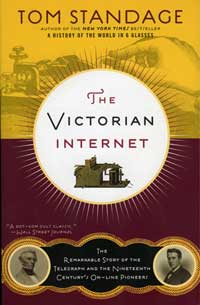 If you think the Internet has changed communications in recent years, consider the effects of the introduction of telegraphy 150 years ago. Communications went from as slow as horses, ships or trains could carry news to instantaneous! Who was the first to use it? Stock traders, of course, and low latency is still their goal! It's a good read, and you'll find out some new info on Thomas Edison! On Amazon. Broadband Properties Webinar Archives  Lots of interesting webinars, mostly on FTTH. Go here. FTTX Networks An ADC white paper on how they work and how networks are upgraded to FTTH. http://connectedplanetonline.com/images/CP-ADC3-WhitePaper-v4.pdf. JDSU Application Note On "Qualifying FTTH Network before Equipment Installation" Another great paper from JDSU covering FTTH PON networks is available for downloading. It gives an overview of FTTH architecture, cleaning connectors then testing the cable plant with OTDRs and OLTSs. This paper will help you understand why OTDRs can be confusing on PONs! Best Practices For Wireless Backhaul Network Upgrades Joan Engebretson, Contributing Editor of Connected Planet has written a very good overview of how fiber is essential to the operation of cellular wireless systems. Everybody probably knows that fiber is used to connect towers into the telecom network - they call it backhaul - but her article also covers the new appliations to replace bulky, heavy, lossy coax up the tower to the antennas. http://connectedplanetonline.com/images/CP_ADC2_WhitePaper.pdf. Fiber Optic Safety Poster We've had numerous requests to reprint our guidelines on safety when working with fiber optics, so we have created a "Safety Poster" for you to print and post in your classroom, worksite, etc. We suggest giving a copy to every student and installer. Corning now offers videos on  .
Lots of interesting videos, some technical, some sales, but all good
information. .
Lots of interesting videos, some technical, some sales, but all good
information.US Conec's videos on cleaning fibers - show's the results of proper cleaning. Webinars of Interest Broadcast Engineering Magazine - Fiber Optic Testing FOA President Jim Hayes presents an overview of fiber optic testing for all applications. Available on Demand. Sign up here. Multimode Fiber Trends from TIA's Fiber Optics LAN Section Ryan Chappell, Draka Communications, looks at the evolution of multimode fiber, examines its current usage and shares predictionson its future Available on-demand at: http://www.brighttalk.com/webcast/7182/play OSP Magazine Webinars OSP Magazine (OSP as in outside plant telco) is now offering a number of interesting webinars that cover fiber topics, including network design and specialized components. http://www.ospmag.com/events/web/ Multimode Fiber Characterization Launch Condition Considerations - new ap note from JDSU JDSU Reference Guide to Fiber Optic Testing – Volume 2 Published  The second volume of the JDSU series on fiber optic testing has been published. Volume 1 focused on Basic Fiber testing and Volume 2 is geared toward fiber optic installers, project managers, telecom technicians and engineers who need to understand fiber networks. Volume 2 also covers Chromatic Dispersion, Polarization Mode Dispersion, Attenuation Profile and Fiber Link and Network Characterization. A 3rd volume, a glossary of fiber optic terms, is also available for download. This is a "MUST HAVE" for all fiber optic techs. Download your free copies here. We used this book as one of our references in creating a new page in the FOA Online Reference Guide on chromatic dispersion (CD) and polarization-mode dispersion (PMD). Careers in Fiber Optics: Brian Smith. A 1998 book on fiber optic jobs is a bit dated, but a free overview is on Google Books and worth a look at it online. Dirt! As much as 70% of the problems associated with deploying fiber to the home result from something as simple as dirty connectors according to JDSU. Telephony Online. US Conec's videos on cleaning fibers - show's the results of proper cleaning. Good Technical Websites American Polywater (http://www.polywater.com/) has one of the best technical website for cable installers. Here is a rundown on some new material on their site. Cable Installation using "Push" or "Push/Pull" Polywater's new Pull-Planner™ 3000 Software allows a "pushing force" variable in pulling tension calculations. Read a White Paper that quantifies the push contribution and compares calculation results to field experience. -- http://www.polywater.com/pushing.pdf Pulling Cable Through Water? Read a Product Spotlight on Polywater® + Silicone™, Polywater's new generation underground lubricant. Continued reduction of friction when pulling through water is only one of the unique features of this lubricant. -- http://www.polywater.com/NNNBSL.pdf Check out their website, especially “Videos,” “Engineer’s Corner” and “Calculators.” http://www.polywater.com/NNNBSL.pdf  " Heard on the Street" is a monthly online newsletter from Frank Bisbee of Communications Planning Corporation that covers the telecommunications and cabling businesses. Each month includes news from manufacturers, trade associations and professional societies like the FOA. You can read the current issue and back issues online.  JDSU has announced the See the Light webinar series, a four-part program designed for anyone involved in the installation, maintenance, and repair of fiber optic systems. It begins with fiber inspection and cleaning and then covers the basics of fiber testing. The webinar series then continues with the more advanced optical time-domain reflectometer (OTDR) and fiber local area network (LAN) testing challenges. More information on the series. IGI is offering a series of webinars on topics of interest to those in the communications industry. You can join them live ir download from the archives. IGI WEBINAR ARCHIVES UP AND RUNNING - VISIT TELECOMBRIEFINGS.COM TO DOWNLOAD! IGI, a major market research and technology reporting company (the "Active Optical Cables" below) is offering a a free one year subscription to one of our fiber optics newsletters to FOA members. All they have to do is to send IGI an e-mail stating which newsletter they would like to get. See http://www.igigroup.com/nl.html for a listing of IGI Newsletters. A Fiber Optic Tester In Your Pocket? (See the video on Yes! The camera in your cell phone is sensitive to infrared light - lots more than your eye - and can detect light in an optical fiber or from a transmitter. Chris Hillyer,CFOT/CFOS/I, Master Instructor, Northern California Sound & Communication JATC sent us some photos showing how this works and the following description. 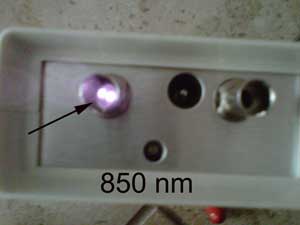 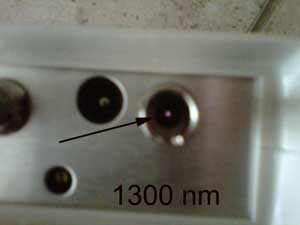 "Your cell phone camera's image sensor can read IR light. It uses this technology to help take pictures at night. In the advanced audio and CCTV field they have been using the smart phone camera to trouble shoot problems in IR communications. The human eye cannot see the IR light emitted by let’s say a remote control. Well up until now we would always say that the remote is out of batteries, or either the IR transmitter or IR receiver was not working properly. Now we can use your smart phone camera to see the IR light emitted by the IR transmitter. All you have to do is turn on your camera function on your smart phone and hold it up the remote control and push any button. The cameras screen will show the IR light. Now back to Fiber Optics. If you follow the same principals of the last paragraph, let’s say you wanted to check if a fiber port was energized. You can either use the card that is supposed to show you in a few seconds that the port was hot. Or you could plug in your meter, in this case it takes some time to find the card or if you don’t have your meter handy. Just pull out your smart phone turn on the camera and hold it over the port. If it is hot you will see a bluish white dot in the fiber bulk head (see attached pictures)." We tried this ourselves and found our camera phone very sensitive at 850 nm but as expected less so at 1300 nm, like all semiconductor detectors. Our phone could still see 1300 nm sources at around -20 dBm, making it very useful even for LED sources, and of course, perfect for lasers. OFSTP-14 Update OFSTP-14 is the TIA standard for testing installed multimode fiber optic cable plants which has been around more than 20 years and is the one TIA standard probably most familiar to contractors and installers. The TIA has adopted IEC 61280-4-1 as the replacement of OFSTP-14. Most of the two documents is the same, with some important exceptions.
We are creating a web page to explain the differences and will give you a link shortly. In the meantime, continue testing as usual.
New Corning Cleaver for Unicam 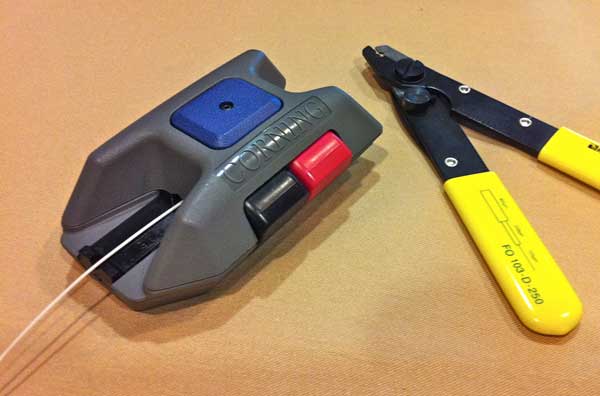 At a recent Corning seminar, we had the opportunity to try their new Unicam Pretium cleaver, the FBC-007 ("007 - licensed to cleave"?). It's a major step forward in making cleaving a trouble-free process and should improve Unicam losses and increase yields. It is included in new kits but can be purchased as an upgrade. Protecting Pedestals From Rodents Pedestals and underground vaults can be damaged by rodents who come up through the base and damage cables. Uraseal "Drain N'Seal" foam deters mice from taking up residence in your pedestals. They have some good videos on using their product. A Cable Tie That's Fiber Friendly We're always warning installers not to tighten cable ties too tightly around fiber optic cable (or UTP copper cable either!) A better choice is the hook and loop fastener ties (Velcro is one trade name), but there is another type, the Mille-Tie. It's an open tie that can be used at any length, then cut off and the remainder used also. Take a look a the video to see how it works. Mille-Tie Video: http://www.youtube.com/watch?v=QPVTQGKmcvE The FOA has updated its Reference Guide page on bend-insensitive fiber. ~~~~~~~~~~~~~~~~~~~~~~ OFS has Creted a White Paper on B-I Fiber That Questions Its Value Quote: Studies have shown that sharp kinks in a jumper (such as would be caused when a jumper is closed in a cabinet door) can lead to fiber breaks. Encouraging installation practices that result in tight bends and kinks by using BI-MMF in the data center is both mechanically dangerous and unnecessary. Modern cable management systems and easy, common installation practices enable high density with reliability. Quote: Figure 4 shows that the system penalties for fibers with poor higher order mode control are significantly higher than fibers with good control of all modes. This variation in performance indicates that substantial work is required to properly classify bandwidth in BI-MMFs. Higher order modes (17th, 18th and higher mode groups) propagating in BI-MMFs can make system performance much worse than predicted by current standards. http://www.ofsoptics.com/resources/Is-There-Value-in-BIMMF.pdf ~~~~~~~~~~~~~~~~~~~~~ Corning ClearCurve® Bend-Insensitive (BI) Optical Fiber Compatible With Other Multimode Fiber Types See the Corning Web Pages On BI Fiber for more details. Corning ClearCurve® multimode optical fiber combines the high bandwidth performance of laser optimized fiber types, e.g. Corning InfiniCor® SXi (OM2), InfiniCor®SX+ (OM3) and InfiniCor® eSX+ (OM4) fibers, with advanced macrobending performance. ClearCurve® multimode is specifically designed for Enterprise networking applications such as LAN (local area network), SAN (storage area network), campus networks and Data Centres. All Corning ClearCurve multimode fibers are able to support transmission speeds of 10/100 Mb/s through to 10Gb/s and are ready for next generation speeds of up to 16/40/100 Gb/s. • ClearCurve OM2, OM3 and OM4 multimode fibers are compliant and fully backwards compatible with all relevant industry standards;
multimode installed base
• ClearCurve multimode fiber may be spliced or connectorized to conventional 50/125 fiber types with commercially available equipment and established practices and methods; no special tools or procedures are required. Testing has been done with Corning fibers and various competitive standard and bend insensitive fibers and no issues were observed. Corning has stated that all their MM fiber will be BI fiber and has created an app note on how to implement the TIA-spec mandrel wrap with this fiber. Here is the complete information reported in the FOA April Newsletter. Benchtop Connector Cleaner 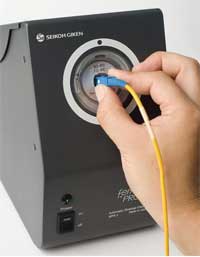 FerrulePro™ is the world’s first fully automated benchtop fiber connector cleaner for laboratory and cable production environments. It automates the final cleaning of all types of terminated fiber products, a critical task where performance once depended largely on the production line worker’s skill. Fiber connectors can be cleaned in 3 seconds cycle - eliminating the need for re-cleaning after post production inspection. More.
They're still being used for high power laser delivery - up to 80-100W! Seikoh Giken has even introduced some new ones. Used Test Equipment – Buy or Sell http://www.testequipmentconnection.com/ Have you read the FOA Tech Topics on Cleaning? More links on cleaning: Cleantex Alco Pads Testing FTTH JDSU shows how to test a PON with an OTDR: http://www.jdsu.com/other-literature/PON-OTDR_fop_an_ae.pdf
|
What Is The FOA? Hear FOA President Jim Hayes tell the FOA Story in a 2-part interview by Sound & Video Contractor Contributing Editor Bennett Liles. It tells about the FOA history, goals and achievements. Part 1: http://svconline.com/podcasts/audio/fiber_optic_association_part1/index.html. Part 2 http://svconline.com/podcasts/audio/inside-fiber-optic-association2-0924/index.html. |
|
Digging Safely (Read the FOA Tech Topic) There is a new toll-free "call before you dig" number: 811 See www.call811.com for more information National Fiber Optic Protection Summit: By the "811" group. March, 2008 in Vegas.
|
|
|
Employment New FOA Jobs Website We get many questions from CFOTs, students at FOA-Approved schools and others contemplating getting into the fiber optic business regarding jobs in fiber optics - and how to find them - so we’ve created a new web page to share some information we've gathered about jobs in our industry. The information is designed to help you understand what jobs are available in fiber optics, how to find them and apply for them. While the overall economy is pretty bad - you've probably heard that there are 5 times as many people unemployed in the US as there are jobs available, telecom is a bright spot - broadband is a major focus of stimulus spending in the US and countries around the world are building fiber networks as fast as possible. Even wireless companies have to build fiber for their backhaul. Cities are installing fiber linked surveillance cameras and smart traffic lights. Fiber is the link making Smart Grid possible. Companies like Allied Fiber are building large private networks. Telecom is one of the fastest growing businesses worldwide. If you are looking for a job in fiber optics, here is the FOA's guide to jobs. The FOA has created a group on A list of 10 ways to get your resume noticed from Marketplace on NPR Jobs Created As Part of Stimulus-Funded Projects The federal government is spending 7.2 billion dollars on the Broadband Technology Opportunities Program. This money is working it's way into the economy and hopefully will provide jobs. You can track recovery dollars and look for job opportunities on this website: www.recovery.gov Go to "opportinities" link then "jobs". You will see a section “find recovery jobs” – enter “fiber optic jobs California” or wherever you are and review what comes up. One of the projects funded by stimulus money is the1100 mile network of Maine Fiber Company Inc. which has selected nextGen Telecom Services Group Inc. as the installation contractor. CFOTs: NextGen has a link on their website for applying for jobs Current Job Openings EM4 EM4 designs, develops and manufactures state-of-the-art, ruggedized, optoelectronic components and packages for the Defense, Aerospace, Life Science, CATV, Telecommunication and Industrial markets. EM4 is part of a global group of specialized optical companies that form Gooch & Housego. Lead Engineer : Fused Technology EM4 is seeking an experienced Lead Engineer to join our team to work on the transfer and operation of the semi automated Fused Coupler capability in conjunction with Gooch &Housego (G&H) located in Torquay, UK. The role involves practical hands on product manufacture, development and first line technical support together with a full suite of project management skills to effectively communicate across G&H sites and with external customers. You will be responsible for learning the fused coupler product line in the UK and moving the manufacturing processes and equipment to the US. Engineering Program Manager EM4 is seeking a talented Engineering Program Manager with a proven track record of managing complex programs to a timely and cost effective conclusion within the Defense Industry. The ideal candidate will have small company experience with fiber optics, photonics, electro-optics, lasers and optics; and an established contact base from which to draw suppliers and customers. The position is headquartered out of the Bedford, MA office of EM4. Quality Manager EM4 is seeking an experienced Quality Manager to join our team to work on implementing the necessary quality management systems to enable AS9100 accreditation. As the AS9100 standard is a fundamental requirement within the markets we operate, it will enable further growth within our product ranges; optoelectronic, fiberoptic, electronic and RF components and subsystems. Additionally, it will ensure the necessary control systems are in place in support of future integration opportunities with our corporate company Gooch & Housego. Package Design Manufacturing Engineer EM4 is seeking a talented Package Design Engineer to join our team to work on new and existing projects and programs. The Package Design Engineer will provide optomechanical design and integration engineering for optoelectronic, fiberoptic, electronic and RF components and subsystems. FOR ALL POSITIONS US Citizen or Green Card Holder required. Outstanding compensation and benefits package to all employees. EM4, Inc., 7 Oak Park Drive, Bedford, MA 01730 Please submit your resume to jobs@em4inc.com OSP Engineers, Southeast (6/11) ASTS is excited to be working with a major company who requires OSP (Outside Plant Engineers) of varying levels of expertise and skill sets to work throughout the Southeast region of the USA. AT&T, BellSouth, BSTCAD, OSPCM, OPEDS permitting and FTTCS design on your resume will get you noticed. NO PHONE CALLS. DRIVER’S LICENSE, BACKGROUND/DRUG SCREEN MANDATORY. Please submit resumes to Alison.King@kbr.com. OSP Techs in New England (6/11) Superior Communication Services (SCS) is atop the premier communications contractors in the New England that provides a variety of communication services to commercial business applications. At SCS we specialize in the design and installation of structured cabling solutions we are now hiring experienced structured cabling technicians to full time positions at our Massachusetts location. Technicians must have a valid drivers license, basic understanding of cable pulling and basic knowledge of using hand tools; we are willing to train motivated and positive individuals. To learn more about this opportunity or to forward your resume, please contact me at scottsavard@scs08.com. Scott Savard Account Executive Superior Communication Services 508-397-9747 www.scs08.com Cable Manufacturing and Development Engineer (4/11) Chromis Fiberoptics has an immediate opening for a cable manufacturing and development engineer. The successful applicant will be responsible for overseeing the manufacturing and development of numerous cable products based on plastic optical fibers. Responsibilities include managing the operation, upgrading, and maintenance of cable manufacturing lines, maintaining a related quality control system, and managing a small production workforce. The successful applicant will also be responsible for development of new cable types, including material selection, process engineering, and customer interactions. Experience and education in areas related to precision extrusion processing are a requirement. Experience and training in optical cable manufacturing are highly desirable, but not required. Experience in manufacturing precision custom extrusions, cables, or tubing are also desirable. Basic electrical and machine tool skills are also a requirement. Management experience in a high-tech manufacturing environment is highly desirable, but not required. Bachelors or Masters Degree in Mechanical Engineering, Polymer Engineering, Chemical Engineering, or related field is expected, but other applicants with exceptionally relevant backgrounds will also be considered. Chromis Fiberoptics is located in Warren, NJ. They manufacture a variety of patented polymer optical fiber products for data-center, consumer, and building networking applications. As a small, fast-growing company with a compelling product, they offer an opportunity to work with accomplished, highly motivated colleagues, and an excellent chance for a well-qualified individual to advance and grow with the company. They have a very competitive compensation plan, including medical benefits. Further information is available at www.chromisfiber.com. Email: hr@chromisfiber.com Do listings in the FOA Newsletter Work? Here's feedback: "We did great! We have over 15 interviews next week." "Your newsletter generated a significant number of applicants and we have filled the position." |
|
We already have winners for July! You can check the answer below. July 2011 We mention above the controversy over bend-insensitive fiber. What was it all about? A. Cost if BI fibers B. Cabling methods for BI fibers C. Compatibility of BI fibers to legacy fibers D. Splicing BI fibers Go here to answer the question. Be sure to enter the month of the quiz!
Your Name, CFOT® - It pays to advertise! The FOA encourages CFOTs to use the logo on their business cards, letterhead, truck or van, etc. and provides logo files on this site for that purpose. But we are also asked about how to use the CFOT or CFOS certifications. Easy, you can refer to yourself as "Your Name, CFOT" or "Your Name, CFOS/T" for example. Feel free to use the logo and designations to promote your achievements and professionalism! |
|
Remember To Renew Your Certification ! Remember
to renew your FOA certification. All current CFOTs have a ID Card with
their certification data and we keep a database of current CFOTs to
answer inquiries regarding your qualifications if needed. You must be a
current FOA member and CFOT to participate in our online
database of installers, contractors, technicians and consultants.
If you forgot to renew, use the online application
form to renew NOW! You can now renew your FOA certification online - and get an extra month free. Details here. |
|
|
We mention above the controversy over bend-insensitive fiber. What was it all about? A. Cost if BI fibers B. Cabling methods for BI fibers C. Compatibility of BI fibers to legacy fibers D. Splicing BI fibers See the FOA Reference Guide for more info. Gt (C)1999-2011, The Fiber Optic Association, Inc. |